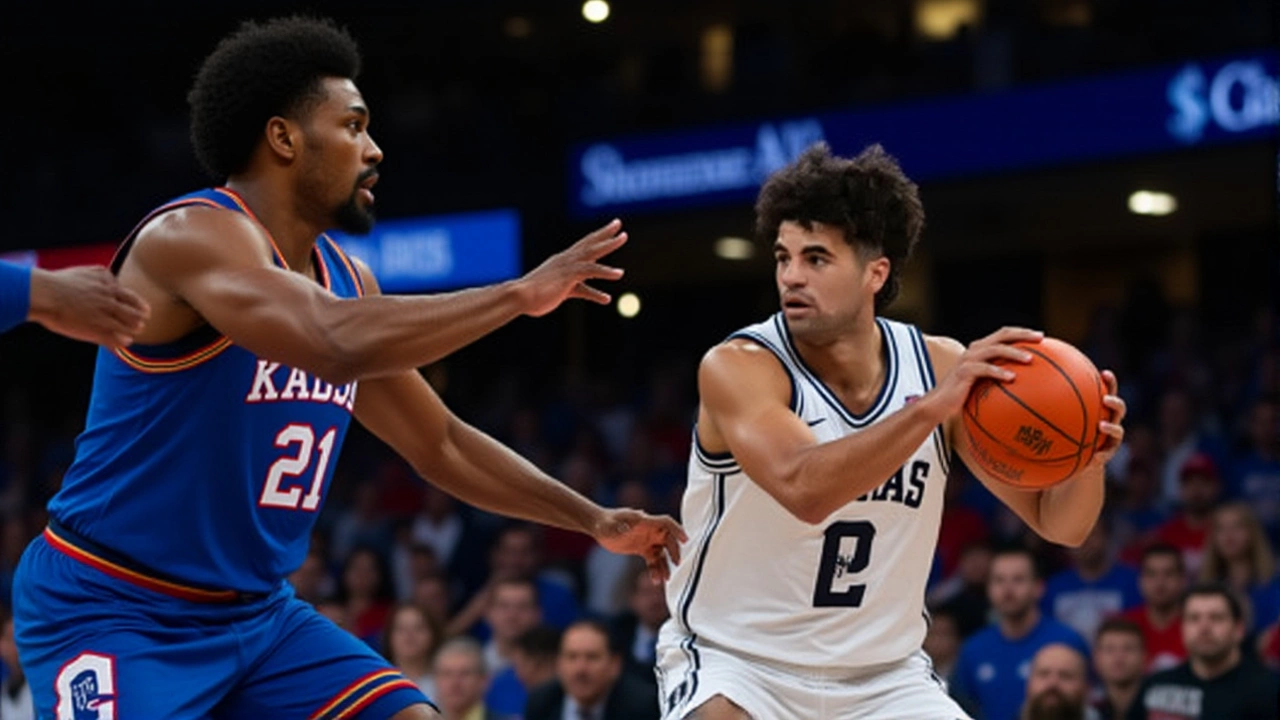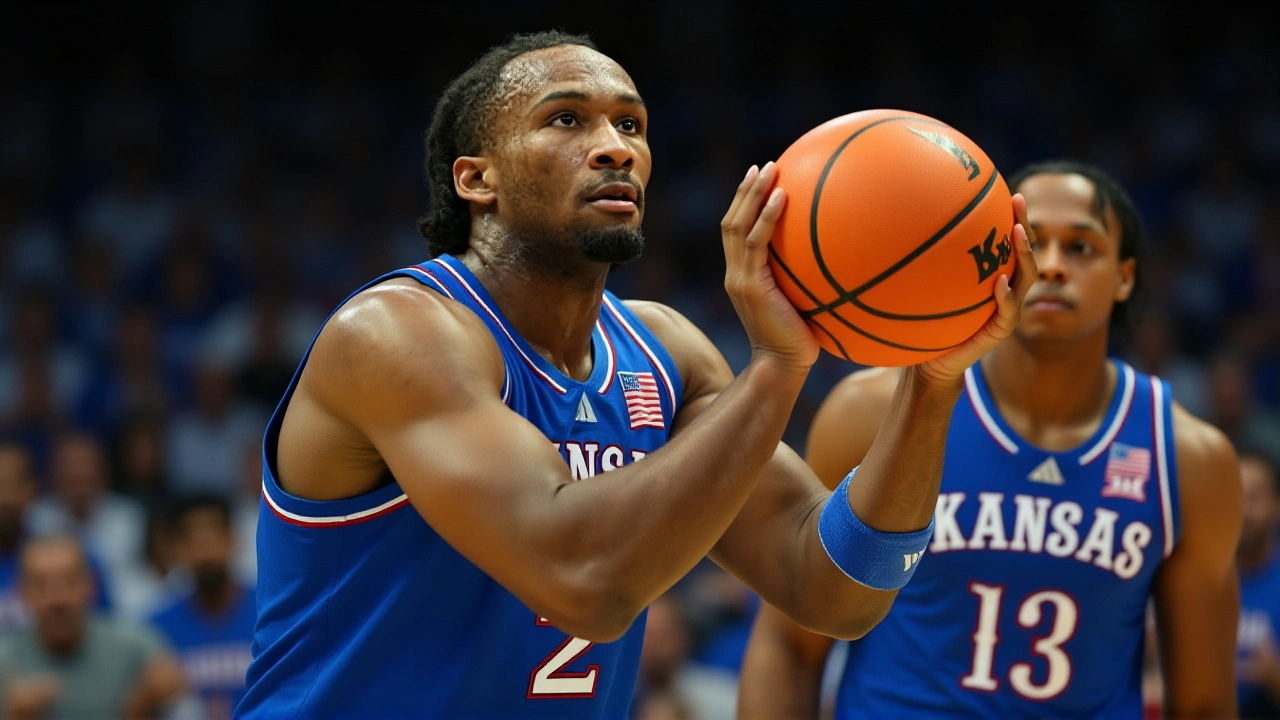When the Kansas Jayhawks tipped off against the undefeated Duke Blue Devils at Madison Square Garden on Tuesday, November 19, 2025, the arena buzzed with anticipation — but not for the reason fans expected. Without their 5-star freshman guard Darryn Peterson, sidelined by a hamstring injury, the Jayhawks looked flat, disjointed, and ultimately outmatched in a 78-69 loss. The absence wasn’t just a statistical gap — it was a psychological void. And the numbers told the story: analysts estimated Kansas lost roughly 22 points from Peterson’s absence alone.
What Happened Without Peterson?
He wasn’t just a scorer. At 6-foot-6, Peterson brought elite defensive versatility, ball-handling, and playmaking that Kansas simply didn’t have elsewhere. One YouTube analyst noted at the 101-second mark: “I think Kansas wins the game tonight. Not only would they have been better offensively obviously, but he gives them such a great defensive presence.” Another added at timestamp 258: “But they need shooting. They need right now they need shooting badly, especially without Darryn Peterson.”
The Jayhawks shot just 37% from the field — their worst performance of the season. Their bench contributed only 12 points. Meanwhile, Duke’s balanced attack, led by freshman phenom Jamal Turner, exploited Kansas’s lack of perimeter pressure. Without Peterson’s ability to guard multiple positions, Duke’s guards found open looks all night. The result? 11 three-pointers for Duke, and just five for Kansas.
Coach Self’s Dilemma
Bill Self, the 62-year-old head coach of the Kansas Jayhawks, remained publicly optimistic but privately cautious. “We hope Darryn plays in the Players Era,” Self told reporters after the game. “But we’re not going to rush him. He’s too valuable to risk.”
Self’s words echoed what insiders have been saying since Peterson’s injury on November 8 — a minor strain suffered during practice in Lawrence, Kansas. The medical staff has been treating him with a strict regimen of rest, ice, and low-impact mobility work. No aggressive rehab. No early return. “They’re not going to put him in a position where they’re going to lose him for six weeks,” one analyst said during the post-game breakdown. “He’s too valuable right now.”
Why Peterson Matters More Than Stats
Recruited as the No. 3 overall prospect in the 2025 class, Peterson wasn’t just a scoring threat — he was the glue. He averaged 18.3 points, 5.1 assists, and 2.8 steals per game before the injury. But his impact went deeper. He initiated the offense with poise, made smart passes under pressure, and had a knack for hitting mid-range jumpers when defenses collapsed.
“He can catch lobs and he can do some other things to keep his confidence in the game, not just shooting,” noted the same YouTube analyst at timestamp 247. “He’s the only guy on this team who can create his own shot consistently.”
Without him, Kansas’s offense stalled. Their second-leading scorer, senior guard Marcus Bell, struggled with turnovers (five in 36 minutes). The team’s assist-to-turnover ratio dropped to 1.1 — its lowest of the season. And defensively, they lost their best perimeter lock-down option. Duke’s guards averaged 1.2 points per possession against Kansas’s secondary guards — nearly double their season average.
The Players Era Festival: A Turning Point?
The next major test comes in two weeks: the Players Era Festival in Las Vegas. The Jayhawks are scheduled to arrive on December 1, with a medical re-evaluation set for the morning of December 2. That’s when the decision will be made — return or rest.
“They’ll be re-evaluated obviously before they go to Vegas,” the analyst said at timestamp 306. “But no one knows this.”
For Kansas, the stakes couldn’t be higher. A win in Vegas could salvage their NCAA Tournament resume. A loss — or worse, another injury — could derail their national title hopes. The team’s RPI dropped to 32 after the Duke loss. They’re now fighting to stay in the top 25 of the NET rankings.

What This Means for the Season
This isn’t just about one game. It’s about momentum. Kansas had won seven of their last eight before Duke — but they’d been playing with a thin rotation. Without Peterson, they’ve exposed a glaring weakness: they can’t generate offense when the ball sticks. Their offense ranked 14th nationally in efficiency before the injury. Now, it’s slipped to 38th.
“There’s a lot of people that are questioning if this group is that good,” said the analyst at timestamp 154. “What do they have to do to get there? And is that something that can happen this season in your mind? I think it’s something that could happen. Obviously Darren needs to get...”
He didn’t finish the sentence. But everyone watching knew what he meant.
Behind the Scenes: The Medical Strategy
Kansas’s athletic training staff has taken a conservative approach — no injections, no aggressive stretching, no early return to contact drills. Their priority? Avoiding a setback that could sideline Peterson for six weeks. That’s the line they won’t cross. “Losing him for six weeks would be too detrimental,” said a source close to the program.
They’re using daily MRI scans to monitor inflammation levels and have adjusted his nutrition plan to accelerate tissue repair. The goal isn’t just recovery — it’s peak readiness for Vegas. If Peterson returns, he’ll likely come off the bench at first. But if he’s cleared for full contact, he’ll be back in the starting lineup by December 5.
Frequently Asked Questions
How much does Darryn Peterson’s absence hurt Kansas’s chances in the NCAA Tournament?
Without Peterson, Kansas’s tournament ceiling drops from Final Four contender to first-weekend exit. His ability to create shots under pressure and guard elite guards is irreplaceable. Teams like Purdue, Alabama, and Houston — all potential NCAA opponents — have guards who would exploit Kansas’s lack of perimeter defense. Analysts estimate Kansas’s win probability drops by 40% without him in the lineup.
Why is the Players Era Festival so important for Peterson’s return timeline?
The Players Era Festival in Las Vegas is Kansas’s last major non-conference test before Big 12 play intensifies. It’s also the last chance to prove they’re still elite before the selection committee starts locking in seeds. If Peterson returns and performs, it could boost their seeding from a 5-seed to a 3-seed. If he doesn’t, they risk falling to a 7-seed — meaning a tougher path to the Final Four.
What’s the history of hamstring injuries for top college recruits like Peterson?
Hamstring strains in elite guards typically require 2–4 weeks of rest, but setbacks are common if players return too soon. In 2023, Duke’s Paolo Banchero missed three weeks after a similar strain — and his team lost two key games. Kansas’s medical staff is following the same cautious playbook used by NBA teams: no rushing, no pain tolerance, no risk. Peterson’s case is being treated like an NBA rookie’s.
Who steps up in Peterson’s absence, and can they fill the void?
Senior guard Marcus Bell and freshman wing Elijah Carter have been forced into larger roles, but neither has Peterson’s playmaking IQ. Bell’s turnover rate has spiked 60%, and Carter is shooting just 29% from three. Kansas’s offense has become too reliant on isolation plays — a style that doesn’t suit their roster. Without Peterson’s unselfishness and vision, the offense looks mechanical, not fluid.
Is there any chance Peterson returns before the Players Era Festival?
Unlikely. The medical staff has ruled out any return before December 1. Even if he feels better, the risk of re-injury is too high. Kansas is prioritizing long-term health over short-term wins. The team’s official statement says Peterson is “progressing as expected,” which in medical terms means he’s not yet cleared for full contact. His earliest possible return is December 5, during the tournament.
How does this injury affect Kansas’s recruiting prospects?
It’s a double-edged sword. Top recruits see Kansas as a program that can develop stars — but also one that can’t keep them healthy. If Peterson misses significant time, it could deter 5-star guards from committing. However, if he returns strong in Vegas and leads Kansas deep into March, it could reinforce the narrative that KU is the best place for elite talent to thrive under pressure.

